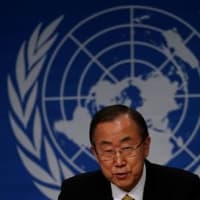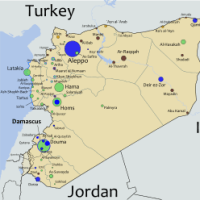

India may have just gotten the wake-up call it needed to start getting serious about its growing pollution problem. A study put out this week by Tel Aviv University reports that Indian megacities are seeing a faster increase in pollution than the cities in the classic environmental villain to the east, China. According to the paper, from 2002 to 2010, Bangalore saw the second highest increase in air-pollution levels in the world at 34%, and Indian cities including Pune, Mumbai, Nagpur and Ahmedabad, among others, also saw double-digit increases. Because the pollution measured reflects a combination of industrial and weather-related particles like dust, it’s not possible to say this is entirely a man-made problem. But the fact that India’s population grew faster than China’s in the past decade means that the air in India’s cities is doomed to get worse before it gets better.
It doesn’t seem fair that China gets both the job-supplying manufacturing sector and the relatively better pollution news. (It’s increasing in Chinese cities too — just not as fast.) But no one in India could claim the information to be much of a shock. Though this is my first winter in New Delhi, everyone keeps telling me that it’s “normal” this time of year for the Indian capital to get smoggy. But how smoggy is normal? So smoggy that companies spam my phone with texts for Ayurvedic asthma cures? Apparently so, because I’ve gotten them. When winter kicks in, the cooler temperatures and still air always bring an annual period of haze to the city, but the pervasive murk that enshrouded the city for the first few weeks of November raised more concerns than usual, and not just mine. According to researchers at India’s Centre for Science and Environment, levels of respirable particulate matter (PM10) in mid-November were up 47% over what they were that time last year, and nitrogen-dioxide levels were up 57%.
(MORE: Serious Air Pollution in Beijing Is Leading to Social Unrest)
Officials have been on the defense, and they should be. New Delhi Chief Minister Sheila Dikshit announced the state had commissioned one of India’s best universities to study the causes of this year’s bad smog, in addition to proposing a series of quick fixes to help clear the air, like restricting diesel-generator use and banning trucks not bound for New Delhi from entering the city. She also has blamed the burning of straw in neighboring states of Haryana and Punjab, a claim that officials there dismissed, correctly pointing out that if that were the problem, they’d be covered in smog too.
The gray cocoon that enshrouded the city earlier in November is at bay for now, which means we can see the sky. That’s a nice change. But it’ll be back. In a study released earlier this year, India ranked last out of 132 countries surveyed by Yale and Columbia in terms of air quality and effects on human health. Because of its high-emissions vehicles and heavy reliance on coal, the country has particularly serious levels of high-particulate matter, which leads to respiratory infections, and the problem is seen both in cities like New Delhi and smaller cities around the nation.
“You always have an increase in respiratory cases this time of the year, partly because of the worsening air quality and partly because of the seasonal changes,” says Dr. S.K. Chhabra, head of the Department of Cardiorespiratory Physiology at the Vallabhbhai Patel Chest Institute in New Delhi. He says he’s been seeing more asthma and bronchitis patients in the past few weeks, as well more cardiac patients with angina, which is aggravated by the lowered oxygen levels during heavy pollution. People with pre-existing lung or heart disease, smokers, young children and the elderly are particularly susceptible. “When the wind starts again, there will be less cases.”
(PHOTOS: New Delhi Demands Water: The Indian Capital’s Annual Shortage)
That doesn’t make it O.K. The New Delhi government has taken steps in the past that have helped control the city’s pollution levels, like rolling out vehicles that run on natural gas to reduce emissions, building a metro system to encourage public transportation and limiting the amount of commercial traffic coming through town. Last week, the Centre for Science and Environment called on officials to do much more, including enforcing emissions checks on private and commercial vehicles, banning open fires in the city and using a smog-alert system to let citizens know when the pollution is particularly risky. Earlier this month, the city announced it would expand monitoring, install electronic displays charting air quality around the city and issue smog alerts and health advisories, according to the Hindustan Times.
Those are steps that have a proven track record in other cities. Growing up in the 1980s in Los Angeles, we used to have regular “smog days,” when public schools would cancel our physical-education classes because the city advised it was unhealthy for kids to be outside. (Some amazing pictures of the bad old days in L.A. here.) L.A. has mostly cleaned up its act through a combination of citizen activism, better technology and better regulation. The alerts were good public-health practice, sure, but they did more than that. They were a reminder that heavy air pollution, even if it was the norm, was not normal. They are also a reminder to citizens that if officials aren’t doing all they can to get things back to normal, they’re not doing their job. If India’s private sector can send me regular text messages about Ayurvedic cures for asthma, surely I could get a courtesy note from the government I pay taxes to when air-pollution levels might give me an asthma attack.


大気汚染、中国より深刻=冬に患者急増、環境基準の10倍以上―インド
時事通信 1月5日(日)15時6分配信
【ニューデリー時事】インドの首都ニューデリーで呼吸器疾患の症状を訴え、
病院に駆け込む患者が急増している。
中国よりも大気汚染が深刻で、ニューデリーでは最大で年間1万6200人が早死にするとされる。
気温の低下とともに、PM2.5やPM10など人体に有害な微小粒子状物質が地表近くの大気に滞留するためだ。
内陸にあるニューデリーは12~1月、有害物質を含んだ濃い霧に覆われる。
数十メートル先が見えないこともあり、航空機の遅延や欠航など交通機関への影響も大きい。
世界保健機関(WHO)の統計によると、中国でPM10汚染が最も深刻とされ、
2009年の年間平均濃度が1立方メートル当たり150マイクログラムの甘粛省蘭州市でさえニューデリーを下回る。
インド政府機関によれば、ニューデリーでは10年、PM10の年間平均濃度は同261マイクログラムで、
WHO環境基準の13倍。05年から2倍近く増えた。
冬季ではPM10の1日平均濃度が470マイクログラム、PM2.5が270マイクログラムを超える日が続く。
PM2.5のWHO環境基準は1日平均25マイクログラムで、ニューデリーの汚染はその11倍に当たる計算だ。
川湯ビレッジでは随時生徒を募集しております

詳しくは
こちら

ご訪問ありがとうございます

 人気ブログランキングへ
人気ブログランキングへ にほんブログ村
にほんブログ村



















※コメント投稿者のブログIDはブログ作成者のみに通知されます